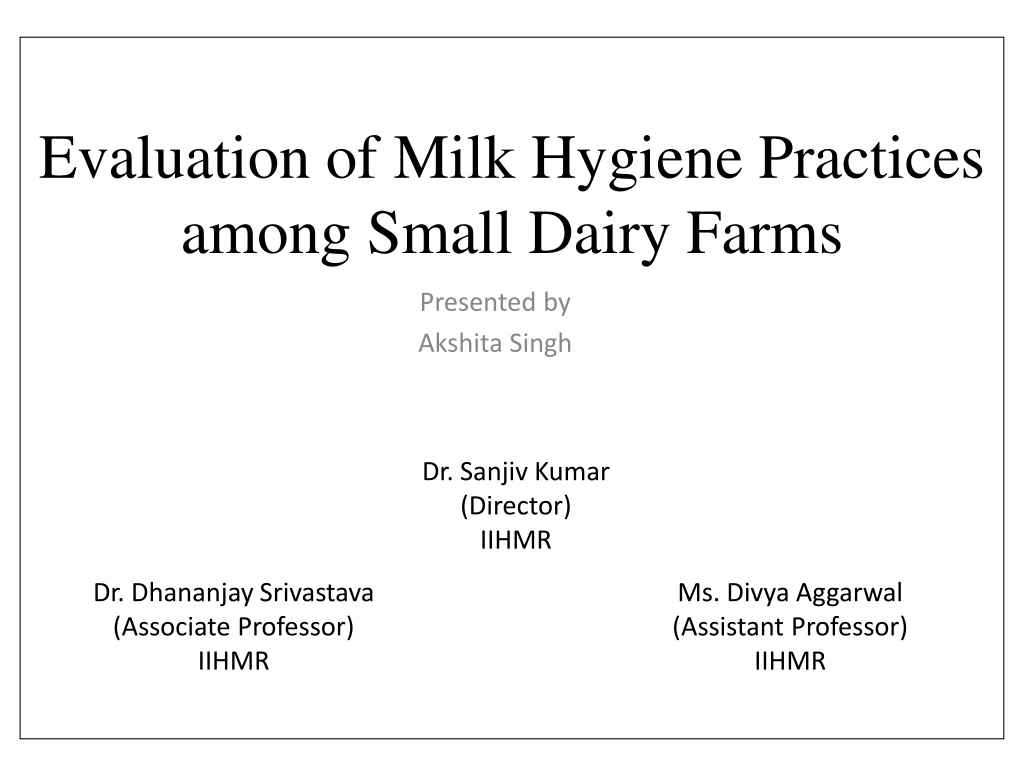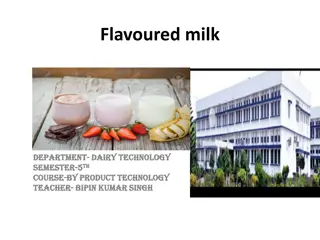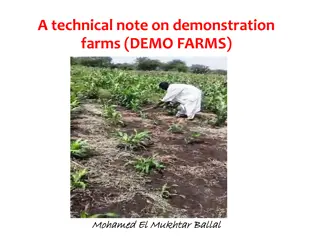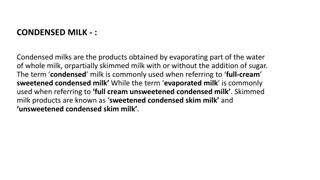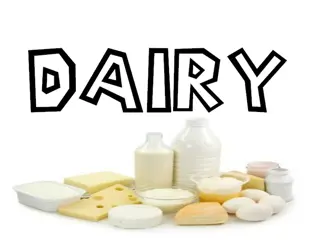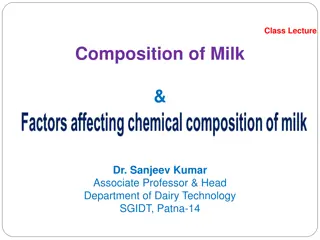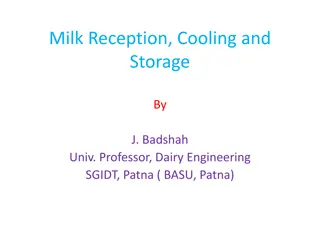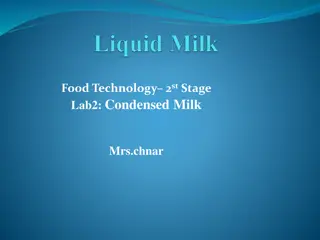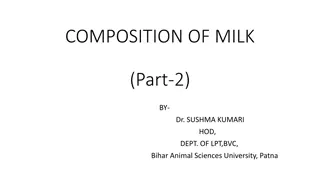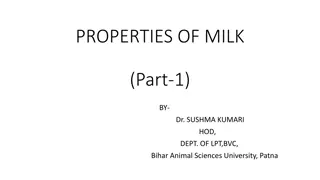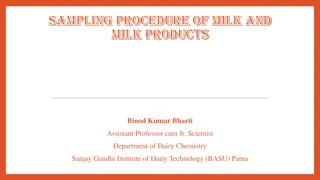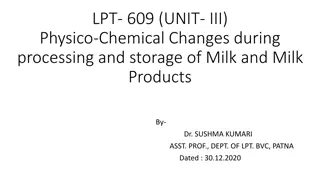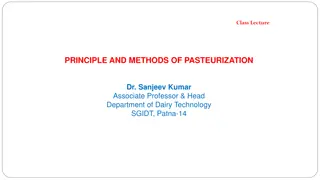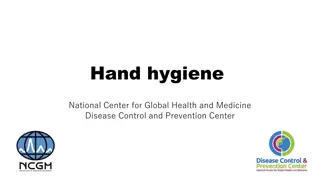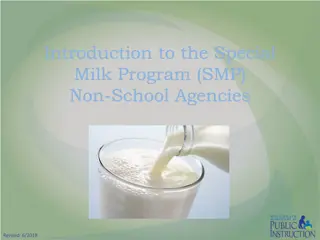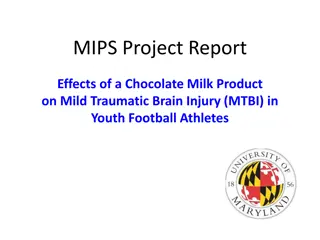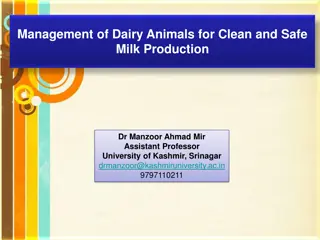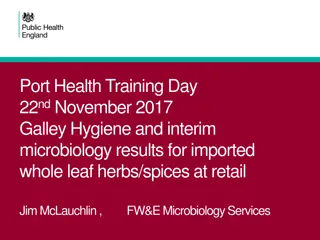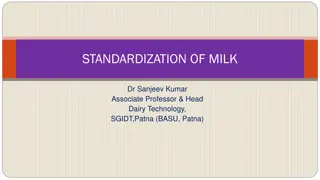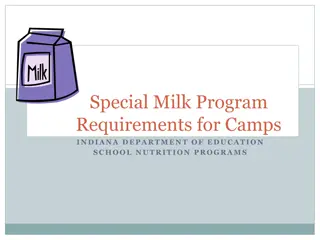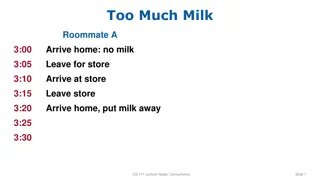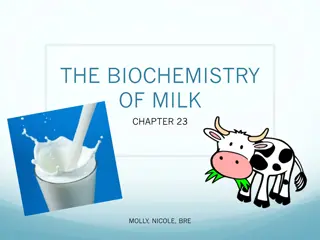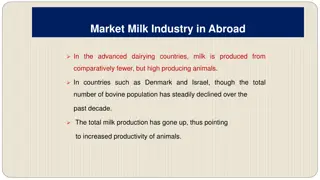Evaluation of Milk Hygiene Practices among Small Dairy Farms
This study conducted in the peri-urban area of Jaipur aims to identify milk distribution systems and evaluate hygiene practices among small dairy farms. The research focuses on the presence of mastitis in milking animals and involves a quantitative, observational study over a three-month period. Key objectives include understanding distribution channels and assessing milk hygiene practices among farmers.
Download Presentation

Please find below an Image/Link to download the presentation.
The content on the website is provided AS IS for your information and personal use only. It may not be sold, licensed, or shared on other websites without obtaining consent from the author. Download presentation by click this link. If you encounter any issues during the download, it is possible that the publisher has removed the file from their server.
E N D
Presentation Transcript
Evaluation of Milk Hygiene Practices among Small Dairy Farms Presented by Akshita Singh Dr. Sanjiv Kumar (Director) IIHMR Dr. Dhananjay Srivastava (Associate Professor) IIHMR Ms. Divya Aggarwal (Assistant Professor) IIHMR
INTRODUCTION - Systematic approach to quality care -Every participant in the dairy supply chain - To create quality system. Why Proper milk distribution system? Milk borne infections - Bovine tuberculosis, Brucellosis, Leptospira infection, Q fever Mastitis -Inflammation of the mammary gland and udder tissue - Immune response to bacterial invasion of the teat canal by variety of bacterial sources present on the farm. A high SCC indicates an udder health problem and milk with a high SCC is known to have shorter shelf life due to high activity of enzymes and high SCC also causes other problems for the dairy industry.
RATIONALE Coordinated public health approach Protects Human Animal One health Health of people Connects Health of animal Environment
Why Safe milk supply ? - To improve nutrition. - To prevent zoonotic disease. - To prevent physical defects arising from malnutrition. - Control of adulteration. Why Peri urban areas ? - Informal milk marketing - Facing hygiene problem. - Zoonotic disease transmission.
AIM To identify the Milk distribution system and hygiene practices among small dairy farms in Jaipur.
OBJECTIVE 1. To identify the distribution system among the small dairy farms in the peri-urban area of Jaipur. 2. To evaluate milk hygiene practices among small dairy farmers under identified distribution system (for e.g. supplier, distributors, end-user etc.) 3. To Check the presence of mastitis in milking animals (Keno test, temperature and pH) among small dairy farms.
METHODOLOGY Study Area- Peri-urban area of Jaipur. Study Design- Cross sectional study. Study Period- Three months. Study Population Person involved in distribution channel for e.g. milk suppliers, distributors, households (end - user) etc and milking animals on small dairy farms.
Study type Quantitative and observational study. Sampling -Snowball Sampling was used for identification of distribution system under small dairy farms. Further all possible supplier was interviewed till the repetition of supplier taken place.
Data collection Tool Questionnaire was used for evaluation of hygiene practices through variables such as Washing of udder, washing of utensils, Teat dipping, Washing of hands etc. S.No. Types of Samples Data Collection Tools 1 Supplier Questionnaire 2 Milk Distributer Questionnaire Checklist 3 Consumers (end- Questionnaire user) Milking Animals 4 pH, Temperature and Keno Test for (Cow s and Buffalos) Mastitis
Analysis Criteria of Somatic Cells count S.No. 1. Results Criteria CMT ( ) (0-200,000) Liquid mixture without gel Light gel visible by transparencies, Will disappear after 10 seconds 2. CMT 0 (>200,000- 500,000) CMT 1 (500,000 3. Visible light gel by transparencies, persistent 10,00,000) CMT 2 (1,000,000 Visible gel Adhesion to the cup vacuous filament 4. 5,000,000) 5. CMT 3 (>5,000,000) Strong gel like the egg white Statistical analysis tool For the purpose of Data analysis Descriptive statistics (Frequency, percentage, average) and correlation analysis was used.
Sampling Design S.No. Sample Sampling technique Sample Size 1 Supplier Multistage snowball sampling was used to 30 identify the supplier which was involved in distribution system. Snow ball sampling was used to identify 2 Distributers 10 distributers from their respective suppliers. Snow ball sampling was used to identify 3 Consumers 40 consumers from their suppliers and distributors. From every small dairy farms one cow and 4 Milking Cows 30 Animals(co one buffalo was selected randomly and it was Buffalos found that few dairy was not having any 28 w s and buffalos) buffalos for testing of mastitis.
DATA ANALYSIS AND INTERPRETATION Identified Distribution System
Evaluation of hygiene practices Supplier response regarding washing of udder before milking. Observation regarding cleaning of udder. WASHING OF UDDER BEFORE MILKING Response Frequency CLEANING OF MILKING ANIMAL UDDER Responses Frequency Percent Percent Yes Clean 24 80 7 23.3 No Dirty 6 20 23 76.7 Total Total 30 100 30 100 Inference As per the result mentioned above it clears that there was a huge difference between suppliers response and researchers observation regarding practice of washing of udder before milking. Out of 30 suppliers 24(80%) reported that they washed udder before milking where as the researcher observation was a bit different where it was found that only 7(23.3%) of them washed udder before milking.
Percent of farms washing utensil with hot water WASHING OF UTENSIL WITH HOT WATER Response Frequency Percent Yes 2 6.7 No 28 93.3 Percent of farms washing utensil with hot water. Total 30 100 Inference As per the results only 6.7 % is washing their milking utensil with hot water. Supplier Response regarding clean water. Observation regarding clean water AVAILABILITY OF CLEAN WATER Response Frequency Yes 18 No 12 Total 30 PRESENCE OF CLEAN WATER Response Frequency Yes No 26 Total 30 Percent 60 40 100 Percent 13.3 86.7 100 4 Inferences As per the result 60% (18) were having availability of clean water but according to the researcher observation only 13.3% (4) were having presence of clean water.
Supplier response regarding frequency of barn cleaning Observation regarding cleaning utensil FREQUENCY OF BARN CLEANING Response Frequency Twice 30 CLEANED UTENSIL Response Frequency Yes No Percent 100 Percent 36.7 63.3 11 19 Inference As shown in the result barn cleaning was done twice a day by every small dairy farmers but as per observation results only 11(36.7) of them were having cleaned utensils. Supplier response regarding teat dipping practice Observation regarding cleaned teats PRACTICE OF TEAT DIPPING Response Frequency Yes No CLEANED TEAT Frequency 3 27 Percent 6.7 93.3 Response Clean Dirty Percent 10 90 2 28 Inference According to the above table only 2(6.7%) out of 30 are practicing teat dipping and it is clearly shown in observation table that only 10%(3) are having cleaned teat.
Results of observation of hygiene practices of suppliers. S.No. 1 Variable Milking area cleaning: Floor Response Percent Cleaned Not cleaned Present 3.3 96.7 Urine 53.3 Not present 46.7 Manure Present Not present Not Present Present Not present Present Not present 63.3 36.7 100 96.7 3.3 96.7 3.3 Uterine discharge Dirt Hairs 2 Milking Animal cleaning: Body Clean Dirty Yes No Yes No Yes No Yes Inside the roof 60 40 80 20 83.3 16.7 96.7 3.3 100 100 3 Proper feeding 4 Proper transport for distribution 5 Proper shed for animals 6 7 Proper ventilation for animals Milking of animals Done at
Evaluation Hygiene practices of distributors S.No. 1 Variable Response Percent 60 Transportation used for distribution Motorcycle Jeep Households Milking factories No Steel Aluminium Tap Top of utensil Do not Serve to Households No 40 80 20 100 60 40 10 70 20 80 2 Milk distribution 3 4 Cooling procedure Utensil used for distribution 5 Pouring of milk through 6 Cleaning of pouring utensil every time before serving milk Do not Serve to Households 20 Inference This Tables shows some variables related to hygiene practices of distributors while transportation of the raw milk. Firstly it shows the transportation mode they are using for the milk supply which shows that they motorcycle (60%) was mostly used. And they supply 80% raw milk to households without any cooling system. Distributors use 60% Steel containers for supplying in which only 10% were having tap system otherwise they serve milk by top of the utensil (70%). Even they do not wash their pouring utensil every time while they serve.
Consumer responses on Hygiene practices S.No. 1 2 Variable Response Percent 100 70 30 40 7.5 52.5 17.5 Consumption of raw milk Storage of milk No Refrigerator Room temperature Sometimes Frequently Never Yes 3 Curdling of milk 4 Feeling of diarrhoea after drinking of milk No Yes 82.5 22.5 5 Milk consumption from other source No 77.5 Inference As per the Results there are 100% consumers who are drinking boiled milk. 70% of the consumers were storing milk at refrigerator and 40% of them had faced curdling of milk sometimes and 52.5% had never faced any curdling of milk. Only 17.5 % of consumers feel diarrhoea after drinking milk and 22.5% are consuming milk from other sources.
Results of Milk Testing for Mastitis Average pH and Temperature of Cattle s Mean of pH and Temperature of Cattle s N Minimum Maximum Mean pH of cows Temperature of cows 4.00 91.20 8.00 100.20 6.10 93.35 30 pH of buffalos Temperature of buffalos 4.00 92.70 7.00 98.60 5.85 95.07 28 Inferences Mean pH of cows and buffalo was 6.10 and 5.85. Mean Temperature of cows and buffalos was 93.35 and 95.07
Results showing pH of cows Results showing pH of Buffalos pH of cows 4.0 6.0 7.0 Frequency 2 24 Percent 6.7 80 pH of Buffalos 4 6 7 Frequency Percent 3 10.7 82.1 23 1 3.3 2 7.1 8.0 3 10 Result showing temperature of cows Results showing temperature of buffalos Temperature Frequency Percent Temperature Frequency Percent 90 -95 14 46.7 90 -95 25 83.3 13.3 46.7 95.1 -100 95.1 -100 4 14 >100 1 3.3 >100 2 6.7
Showing Somatic Cell count of Cows and Buffalos SOMATIC CELL SOMATIC CELL COUNT OF COWS Frequency 2 19 9 COUNT OF BUFFALOS Frequency 8 14 6 Percent 6.7 63.3 30 Percent 28.6 50 21.4 CMT - CMT 1 CMT 2 Inference Above results shows the Somatic cell Count of cows and buffalos which depict the presence of mastitis by California mastitis test. According to the result 63.3% are showing CMT 1 in cows which means they are having risk of mastitis and somatic cell count was 500,000 10,00,000 and 30% of showing CMT 2 in cows which Shows a high risk of mastitis and it can be a mastitis and somatic cell count was 1,000,000 5,000,000. In buffalos 50% are showing the CMT 1 which depicts the risk of mastitis with 500,000 10,00,000 and 21.4% are showing CMT 2 which shows a high risk of mastitis with somatic cell count of 1,000,000 5,000,000.
CONCLUSION According to the first objective Distribution system of small dairy farms was of four types in which supplier is the main person to supply raw milk to three different areas i.e., to households, private dairies and government dairies. Hygiene practices followed by under small Dairy farms were classified by udder hygiene, Teat hygiene, cleaning of milking area, cleaning of milking animals. And it has shown that udder hygiene was according to supplier was showing good result but according to the observer it was completely opposite. In concern with teat cleaning only two dairies are identified who were practicing teat dipping. Clean Milking area of small dairy farms were identified was showing unhygienic condition.
In concern with the presence of mastitis in milking animals their were very few animals who were showing less number of somatic cell count. Majority of animals were in the category of CMT1 and CMT2 which shows the higher risk of mastitis. According to the result we can see that mastitis risk is more in cows than buffalos.
